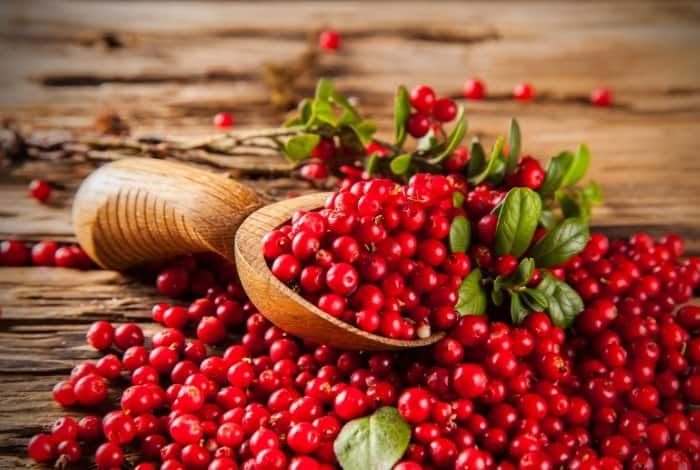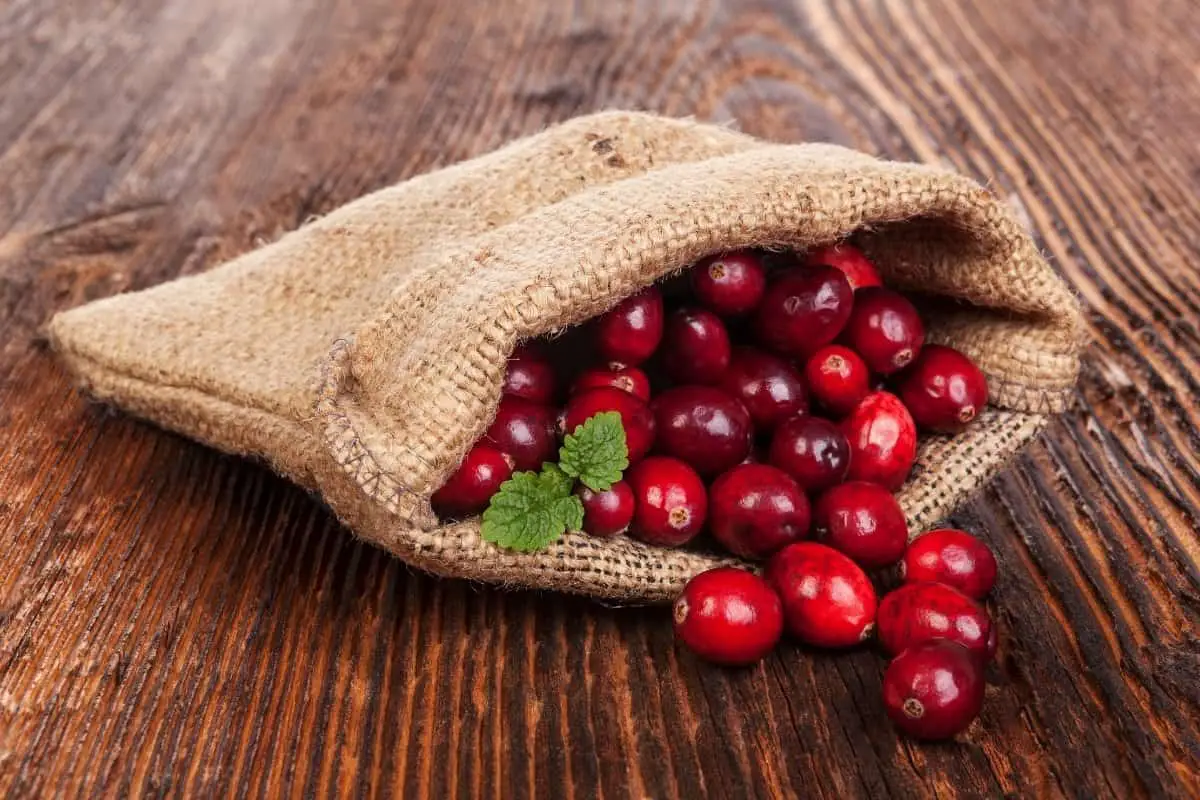Last Updated on February 23, 2023 by Griselda M.
Wondering “When are cranberries ripe?”? Ideally, we need to harvest the berries when they are maximally sweet and not yet rotting. This is the optimal point for harvesting, and there are a few tricks to allow us to determine when this is. Let’s have a look at these helpful tricks to allow you to harvest sustainably.
Ripeness and Sweetness
Brix is a measure of sugar in a juice – it roughly translates to the percent sugar content. When the fruit ripens, the Brix of the fruit increases and the acid content typically decreases.
Cranberries are quite acidic berries. A ripe cranberry has a Brix of about 10.5 – this means that the juice will have 10.5% sugar – compared to an average grape at 21% sugar, you can see this is not the sweetest berry on Earth and even a tough person will go slightly squint eating a few fresh. If a Cranberry is harvested when it is nearly ripe you can end up with a berry that has a Brix of 6-7%. and a lot of acids – you will go squint and shake all over if you eat an evil thing like that and probably get an ulcer. We primarily grow these for use in cooking and making sauces and preserves, or juice (which will be sweetened with honey). I keep frozen cranberries in the freezer and add a handful to a smoothie.
Cranberries, depending on species grow as small vines or bushes lying low to the ground. The berries are oval in shape, deep red when ripe, and whitish-green when unripe. The berries are easy to identify from other berries. The best thing about these berries is they are free from the use of pesticides.
Cranberries begin ripening in September, but it is best to wait till late October or November to harvest them as this is when they achieve peak sugar concentration or peak Brix. As the season progresses, they sweeten and become more edible. If they get hit with a frost and have already turned red, that will be the period at which maximum sweetness or Brix is achieved.
Let’s See What Identifies a Cranberry as Ripe
To understand what identifies a cranberry as ripe, there are 3 main factors to consider – the feel, smell, and color. It should be crimson red, should smell very subtle, and should feel supple to the touch.

Color
Ripe cranberries are crimson red to slightly maroon. A green cranberry means it is immature or not well-grown. The dark purple color means the cranberries are overripe. Color alone is not the only factor that determines the ripeness of these berries. Growing conditions and harvesting time affects the berries’ coloration.
The color of the cranberries comes from a pigment known as anthocyanin. This pigment develops in the cranberry skin when it is exposed to cold or heat. In most cases, you will always see half-white or half-red cranberries. This happens because the half-white side stayed cooled and never developed the red color. You can turn the white cranberries red by popping them in the freezer and this will trigger the anthocyanin cascade leading to the dark red-purple color.
What color are cranberries inside?
The berries range from off-white inside to light pink to red. This depends on the cultivar of the berry, the ripeness level, and the amount of cold and light the berries were exposed to.
Smell
Ripe and unripe cranberries smell almost odorless. Overripe cranberries have a distinctive fruiter and sweeter smell caused by the release of esters. Unripe and nearly ripe cranberries have a waxy skin thicker than a red apple’s skin. The smell does not pass through the skin because it is thicker. When the cranberry starts to spoil, the cell walls start to break down and become goopy and soft. The soft-skinned overripe cranberries are easily damaged. So always buy the ones that have a subtle smell so that it ripens more at home.
Feel
Use the bounce test to tell if a cranberry is ripe or not. As the cranberry ripens, pectinase enzymes convert pectin, a polysaccharide in the wall of the cells into simpler sugars. As this process happens, the cell walls get soft and transparent. This means that a semi-ripe perfect cranberry will make a “bong” sound when it is dropped on a hard surface, and an overripe cranberry will just make a splat sound. And make a splat. This is less good.
Drop the cranberry on a hard surface like a cutting board and see if it bounces. Ripe cranberries are supple and not firm or soft. Bounce a few cranberries to determine if they are ripe or not. Use the ripe one as a guide and compare it with the feel of the others. The sound of ripe cranberries comes from the bounce test- the berry should not plop or splat. Ripe cranberries bounce and make a noticeable ‘bong’ sound. Bong is good.
What to Do With an Unripe Cranberry
If you have sorted your cranberries and selected the best ones, as per above, that are perfectly ripe, you should now have a heap of unripe and green cranberries. You may have a few white cranberries too. Keep the unripe and white ones and read the next section on how to ripen cranberries. Green cranberries are a lost cause – feed them to the chickens, or let the kids throw them at each other. Or use them as mulch on a tree.
How to Ripen Cranberries
The cranberry ripening process is triggered by several factors, with cold being one of the more significant factors. If you place cranberries in your fridge, in a container that allows some air exchange, the berries will ripen slowly.
FLORA GUARD – Professional Tree and Branch Garden Pruner
Read about How to Prune a Lemon Tree
Are White Cranberries Ripe?
The production of anthocyanins is triggered by both light and decreasing temperature. It is therefore possible to have a white cranberry that is ripe. With increasing global temperatures, there are longer-term predictions that for many cranberry regions, there will be more and more white berries harvested, hence producers are even marketing “white cranberries” as a new outlet for these. Personally, it appears that the riper fruits that have developed a red color probably have greater health benefits. I guess at this point we do not know.
How Do you Use Cranberries?
Cranberries can be used in various ways. They include:
- Freeze them as whole berries for eating or inclusion in smoothies
- Make juices or sauces and can them
- Roast the cranberries diced with winter squash and add them to savory rice, or quinoa dish or toss a few into an apple pie
- Make cranberry cheese ice cream
- My favorite is to use them in slow-cooked game meat pots where the acids in the berries really help to soften the meat, and the berry flavor melds with the broth. The acid helps to extract beneficial compounds from the bones as well, making a lovely bone broth.
Are Unripe Cranberries Edible?
Yes, you can eat unripe cranberries as long as they are not rock solid or green. You can eat both ripe and unripe cranberries but immature ones are a different story. In a large batch of harvested cranberries, some are going to be ripe while others are unripe. Unripe cranberries have very high acidity and I have found them to be great included in stews as a meat tenderizer. After a few hours of cooking, the acids in the berry help to reduce the toughness of wild game meat, and the flavor contributed is quite pleasant.
If they are green in color or rock hard, they are not good for eating. Chickens will eat them.
When using cranberries in recipes, it is hard to tell the difference between ripe and unripe especially when sugar is added.
How To Pick Cranberries
Commercially, cranberries that are destined for processing into juice and condiments are picked by water flotation. This allows one to harvest cranberries easily on a commercial scale, however for the small-scale, little home patch of cranberries, you could use a system like this, and a picker like this. For very small patches, you can do this by hand. I grew a few cranberries a few years back and they did not do very well in my area due to the winters not being cold enough.
Picking the fruit was a pain in the neck and really hurt my back – I did not have any berry rakes or anything to make the task easier, and just picked them by hand. I was able to let them ripen to a very bright almost translucent stage in the fridge and we had fresh cranberries in our breakfast smoothies.
Conclusion – When are Cranberries Ripe?
Cranberries are ripe when they achieve peak sweetness and nearly peak softness. If you drop a berry and it goes bong as it hits the table, that is good and indicates that the pectins in the berry are being removed and it is ripe. If it goes splat, then it is too ripe. The smell of the berry changes from largely odorless when it is ripe, to estery when it is overripe due to the waxy layer on the outside of the fruit becoming thinner. Although this sounds confusing, a white cranberry can be ripe – it just has not been triggered by sunlight and cold to produce colors yet.
FAQs
.
FAQs
What Identifies A Cranberry As Ripe?
They are related to both strawberries and blueberries. In the culinary world, one of the most important factors in determining whether a cranberry is ripe or not is its color. The flesh should be bright red with a slight translucence so that it appears moist and fresh. This means that bogs should be harvested before they are completely dark because once they are too dark, the cranberries will no longer be juicy and will taste slightly sour.
Cranberries are berries that have a high water content, which makes them soft, juicy and sweet. Ripe cranberries are usually dark in color and have a high sugar content. Cranberries can last up to three weeks when stored in the refrigerator.
Should cranberries be hard or soft?
The question of whether cranberries should be hard or soft is a debate that has been going on for centuries. In addition to the taste and consistency of the fruits, the size, shape, and color also play a role in which type of berry you prefer.
The answer to the question of whether cranberries should be hard or soft - is subjective because each person prefers to eat cranberries in different ways. Some people like them hard and some prefer them soft.
Some say soft berries are better because they have more flavor. Others say hard berries are better because there are no seeds that can get stuck in your teeth. Regardless, this is not an easy question to answer as there are no clear cut answers for this topic.
Many studies have been conducted on this topic but overall, it seems like nobody is really sure what type of cranberry you should prefer.
Can you eat unripe cranberries?
Unripe cranberries have a very sour taste and they are not easy to chew. The sugar content in them is low. In most cases, these berries can’t be eaten until they’re a little older and dry.
There are lots of people who think that unripe cranberries cannot be eaten and that they are not good for consumption. There is no scientific evidence to support the claim that it is not safe to eat unripe cranberries. Eating them at this point can cause stomach upset.
What should be the texture of a cranberry?
Texture is determined by the type of berry and taste preferences. For example, there are some people who prefer a ribbony cranberry and some who prefer a jelly-like one. Generally speaking, cranberries should be slightly firm with a little bit of give.
The texture of a cranberry should be considered in terms of what it will be used for. Cranberries can be eaten whole or in sauces or as jams and jellies.
How do you pick good cranberries?
The best way to pick cranberries is by visual inspection. Be sure to go through the berries and check their color, size and shape quickly. If they are not perfect, then you should choose another variety.
The right cranberry should be a bright red color with a diameter of no more than one-half inch. The skin should be hard but not tough. Avoid those with mold or spots on it because these can make your pie soggy or affect the taste of your dish.
Should fresh cranberries be soft?
If you are picking fresh cranberries, they should be firm. It is important to note that fresh cranberries should not be mushy and soft. If you find that your cranberries are mushy, they will start to get moldy faster and this will affect their taste.
Caroline is a gardener who loves to get down to the nitty–gritty of gardening. She proudly proclaims herself as a ‘dirt worshipper‘ and can often be found deep in the garden, covered in soil and singing to her plants. As a self–proclaimed ‘plant whisperer‘, Caroline believes that plants need love and attention just like any other living thing, and she loves to give them both. When she‘s not tending to her garden, you can often find her researching the latest gardening trends, or teaching others how to make their gardens thrive



